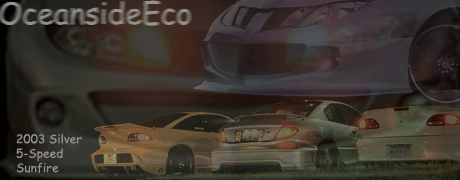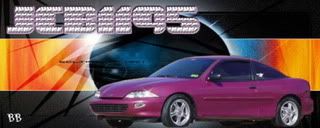This is a semi How-To for swapping Dodge Neon rear discs (using the factory J bearing) onto your car. This doesnít require welding, however it does require a machine shop or access to a milling machine. I would give this 4/5 wrenches. Its not basic stuff, and it does require fabrication skills. I spent about $350 when all was said and done (all the parts except the cables came from the yard). I used Brembo rotors and Hawk HPS pads, but there are literally hundreds of pad/rotor combos out there. Since it retains the factory J bearing, you can keep your ABS if you want. My biggest disclaimer is about the proportioning. I have no idea if this will work with the factory master cylinder. I am using a bigger Bonneville unit with externally adjustable proportioning (which can also be used on 3rd gens if you ditch your ABS). All I can say is once someone tries it, please let everyone else know if it works, or what you needed to do to make it work.
Keep in mind I did this on my 2nd gen. The wheel bearing and drum setup is exactly the same all the way through 04, but the axle and the underbody dimensions are slightly different.
I used the brake setup from a 1996 Neon Sport-

 Needed parts
Needed parts
The setup is the same from 95-02, so any year should work. To do what I did, you will need (part numbers for all this can be found
here-
caliper bracket
caliper
backing plate/dust shield
rotor
ALL internal park brake hardware
balancer for park brake cables (inside car)
new park brake cables
new brake lines to go from hard bent to caliper
To start, remove all the J body hardware (drum, shoes, bearing, backing plate, park brake cables, etc). (There has already been talk of using the factory J park brake cables with the Neon caliper brackets. I have no idea if this will work, so please donít ask. Try it and find out.)
Plumbing
You will need to figure out the brake plumbing. This is entirely up to you. Some info- the Neon uses a 7/16Ē banjo bolt, so your options are pretty open. I used
these braided lines and
these banjo fittings. At the unibody side, I used
this adapter to get back to hard bent.
Some other options-
use the Neon hose and adapter from the salvage yard
install the adapter I used on the axle and use a shorter braided line
or, something entirely different, the options are pretty unlimited here
Park brake cables
You will need to run the park brake cables. I purchased new cables from Mopar. They are part #05273636 (2 reqíd). There are 3 different cables available, Iím guessing for the sedan and coupe variants, but Iím not positive. The cables I used were the perfect length on my 1994. I donít kow for sure if they will work on a 3rd gen. As I mentioned earlier, there is one other swap I know of using another Chrysler disc setup with the 2nd gen J cables. I DO NOT KNOW IF THAT WILL WORK FOR 3rd gens.
This is the Neon cable-

I drilled a 1Ē hole for the cable grommet to go into-

The grommet does move on the cable, and there is a little clamp holding it in place. It was in the perfect spot and I didnít have to move it for my car.
This is the balancer from the Neon. It is not available from the dealer without buying the entire park brake handle, so get it at the yard-

You will need to build a bracket to hold the cable ends. I used ĹĒ steel angle-

I had to shorten the arm on the Cavalier lever to take up the slack since I couldnít move the bracket any farther to the rear-
 Caliper brackets
Caliper brackets
You need to have the Neon caliper brackets machined. This can be done at home, provided you take your time and make sure the center hole is dead on. I had it done at a machine shop for $60.
These are the Neon caliper brackets before machining-

You will need to have the center hole reamed out and the four bearing bolt holes drilled, as well as some clearance cuts made. This is what it should look like after machining-
 Assembly
Assembly
Assembling this is not much more difficult than replacing the wheel bearing. The factory bearing bolts can be used with no issues. Itís a tiny bit more difficult to get them in with the park brake shoes on, but they fit. Once youíve got the bearing bolted up, you need to figure out a way to shim the rotor out so it doesnít rub on the backing plate/dust shield. I used a 1/16Ē thick washer on each stud until I get some plates made to fit. I thought about this problem for awhile. You could space the bearing away from the caliper bracket, but that would leave even less thread on the bearing bolts. It is only about 1/16Ē, so Iíll leave the decision up to you, but the rotor DOES need to come away from the plate, or it will drag.
Finished
Heres some shots of the finished assembly-




I think the best thing about this is that all the wear and tear items can be directly replaced (rotor, caliper, pads, bearing) with factory or aftermarket parts.
Iím pretty sure Iíve covered all the bases for this. I canít stress enough- this was done on my 2nd gen, so the cables may not work on a 3rd gen and you may need to work something else out, but the actual caliper bracket, shield, etc will fit since there is more clearance between the bearind plate and strut on 3rd gens.
Any questions- post away, but please read the entire thing first.













































